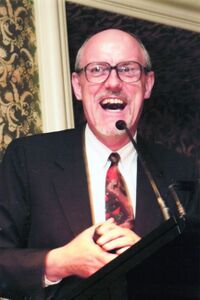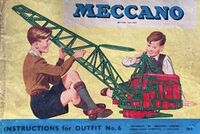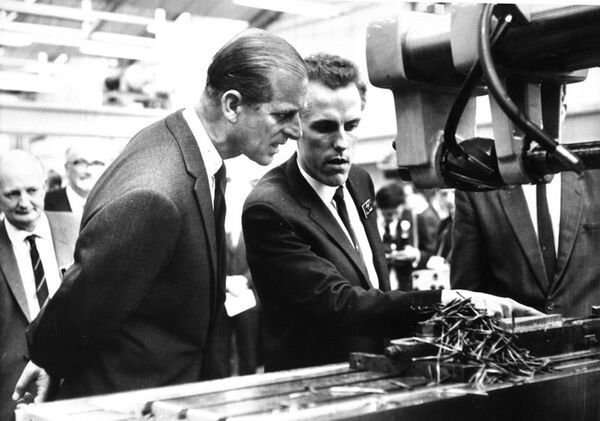Brian J Stone
STONE, Brian James, BSc (Eng) PhD DEng MIMechE CIRP (1943-)
Brian Stone was born on 21 February 1943 in Penarth, South Wales, during the Second World War. At the time, Penarth lay directly under the flight path of German bombers heading to Cardiff docks. His father, James Arthur Stone, worked as a nurseryman and rose to be foreman before joining Penarth Parks where he became superintendent. In 1939 while still a nurseryman, just after war was declared, he married Brian’s mother Mollie Tuckfield.
Brian attended his local primary school and, in 1954, gained entrance to Penarth County Grammar School. In 1961, he entered the University of Bristol to study Mechanical Engineering, according to him, a choice inspired by the Meccano sets he had received from the age of thirteen. These had sparked his fascination with building mechanical models.
While at university, he met Beryl Topley, and they married in 1964, shortly after his graduation.
With a strong interest in vibration, Brian wrote his undergraduate thesis in collaboration with M. G. Jones on vibration with backlash, becoming one the first mechanical engineering students at Bristol to write a computer program. This began a life-long interest in suppressing unwanted vibration. He graduated with a first class honours degree, sharing the IMechE prize for best student.
Brian spent a year experiencing life as a graduate apprentice at the Brush Electrical Engineering Company in Loughborough. At the time, most British engineers spent some time working as a graduate apprentice. In 1965, he returned to Bristol University to undertake a PhD under the supervision of Prof. Colin Andrew, and funded by Machine Tool Industry Research Association (MTIRA). At the time, one of the major challenges for machine tool manufacturers was the unstable vibration commonly known as “chatter” that caused undesirable surface marks on the workpiece surface. These had to be removed with a second machining process.
In 1968 Brian published his PhD research in several papers on improving metal cutting operations by using vibration absorbers. He had developed a systems approach to modelling structural vibration, an approach later applied to many other engineering problems.
Brian began his professional career at MTIRA’s research centre in Macclesfield, Cheshire. He developed a chatter resistant bi-helix milling cutter, earning a patent and significant publicity for the association.
In May 1969, his work attracted national attention when HRH Prince Philip, queen Elizabeth II’s husband, visited MTIRA to see the new technology demonstrated. Despite a coolant spray splashing the Duke, that helped gain wide publicity, the event was remembered as a technical success.
During his time at MTIRA, Brian applied his PhD research into vibration absorbers, further developed bi-helix cutters for milling machines, developed a dynamic performance test for lathes, and wrote one of the first system-based programs for the static and dynamic analysis of machine tool spindles.
In 1972, he returned to the University of Bristol as a lecturer while continuing to consult for MTIRA. He pursued further innovations in chatter suppression, including:
- Designing flexible grinding wheels that were chatter free, resulting in a worldwide patent.
- Introducing continuously varying speeds to suppress chatter in turning, earning the Joseph Whitworth Prize from the IMechE.
- Collaborating on crack detection to analyse vibration.
- Measuring the stiffness and damping properties of rolling element bearings under working conditions, leading to a keynote invitation at the 1982 CIRP annual assembly.
- Investigating the process known as “skiving” (or tangential turning) and showing it to be inherently chatter free which allowed high-feed efficient machining.
In December 1981, Brian accepted the second chair of Mechanical Engineering at the University of Western Australia, where his research broadened to vibration suppression in the mining, oil and gas industries. His work on torsional vibration in rotating machinery addressed catastrophic failures in large diesel generating sets. Insights gained from torsional vibration research also provided feedback to chatter theory, and he conducted modelling and experimental investigations on its effects in grinding.
While pursuing his own research, Brian also became a member of the robotic sheep shearing team as the official UWA academic. He promoted the team’s work to visiting review committees on many occasions.
In Western Australia, Brian published further research on chatter modelling in cutting and grinding, torsional vibration in engines with emphasis on secondary resonance effects, and rod flexibility and coupling to transverse vibration. He developed two novel solutions to remove speckle effects in laser torsional vibration measurements, introduced a time-domain systems approach for thermodynamic systems, invented a torsional hammer for experimental excitation, and collaborated on designing vibration absorber for pipes.
Brian was elected a member of CIRP, the international body fostering research on manufacturing processes. He was also elected as Fellow of the Institution of Engineers, Australia (now Engineers Australia). He served as a member of the Western Australian Science and Industry Technology Council from 1984 till 1987. In 1990, he was the first Australian to be invited by the Japanese Machine Tool Builders Association to be their visiting expert for that year.
Brian served as head of the Mechanical Engineering Department from 1986 till 1991. As well as being an outstanding researcher with more than 140 technical research publications, he was also a passionate teacher. He was almost unique in continuing to teach large classes of first year students while the department head. His infectious enthusiasm inspired generations of first year students to choose mechanical engineering as their major. When he joined UWA, mechanical engineering was the smallest department in the engineering faculty. By the time he retired as head, mechanical engineering was the largest in terms of student enrolment, due in no small part to Brian’s first year teaching.
By 1993, he had developed a strong interest in engineering education research with over 40 publications and many invited keynote speeches at international conferences between then and 2008. With his students, he developed one of the earliest online tutoring systems for mechanical engineering dynamics which subject can be challenging for first year students. This system freed teaching staff from routine assessment tasks, automatically identifying students who needed additional help. Teaching resources could then be focused on students who needed it most. He managed to gain the highest ever number of grants for developing improved teaching methods. His development was one of the few in the world demonstrating improved student learning outcomes using advanced software technology. Three decades later, extensive statistical data confirmed his assertion made at the time, that technology cannot improve student learning without effective pedagogy (teaching methods) that builds on research data. In 1997 Brian was awarded the inaugural Australian national teaching award for Engineering.
Brian served on the council of the Australian Institute for Nuclear Science and Engineering (AINSE) from 1984 till 2004, serving as vice-president and president from 1993 till 1994. In the year of his presidency, AINSE supported 165 grants totalling nearly AUD 1 million.
Brian introduced six-a-side touch rugby to the staff and students at UWA and continued to coach teams in his retirement.
No account of Brian’s professional life would be complete without also mentioning his work as a Christian teacher and pastor. From 1991 till 2018 he served on occasions as a church pastor/elder and teacher. He also lectured on apologetics at both the West Australian and Perth Bible Colleges and served as chair of the accreditation panel for the former. He served as president of the Baptist Churches of Western Australia from 2001 and 2002.
His Christian views were often controversial in academic circles. Brian was forthright in advocating for evangelical Christian beliefs and never shied away from academic debates. The practical application of his Christian beliefs was evident in his care for students throughout his academic career.
Brian and Beryl have three surviving children (one deceased), sixteen grandchildren and fourteen great-grandchildren.
Biography compiled from documents supplied by Brian Stone by Fatima Kazemi and James Trevelyan, August 2025, Western Australia Division
References:
Trevelyan, James (2025) Personal Communication.
Trevelyan, James (1992) Robots for Shearing Sheep: Shear Magic, Oxford University Press.
Google search for Brian's research papers on machine tool vibration


